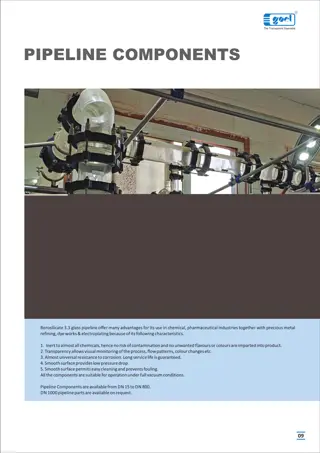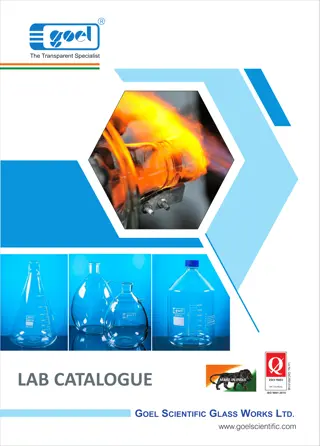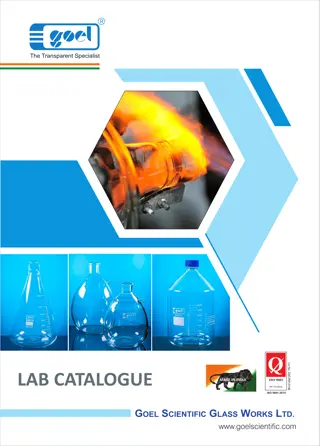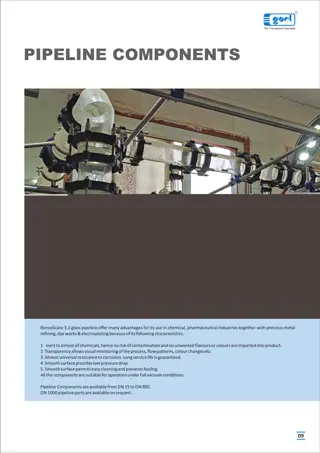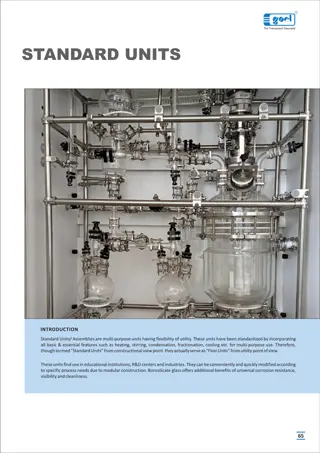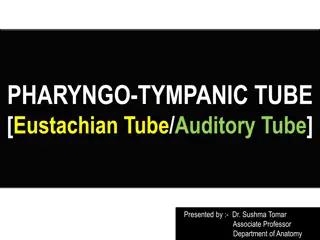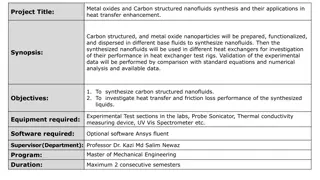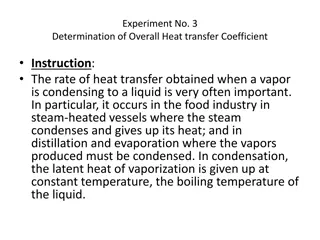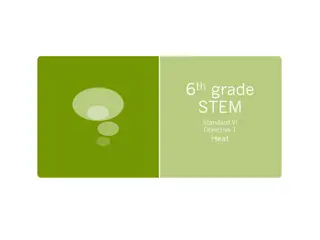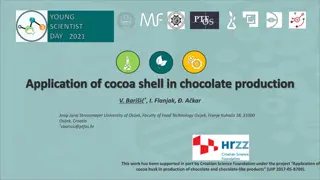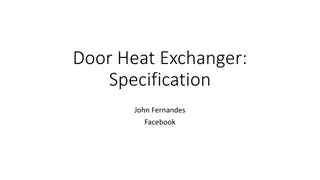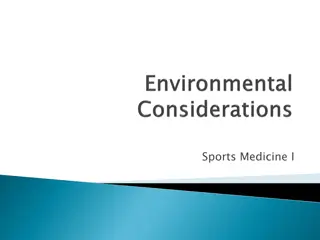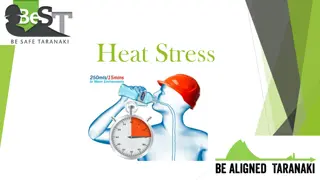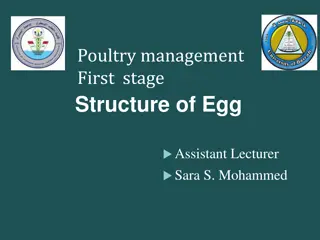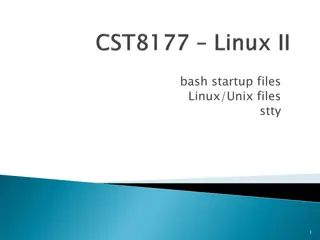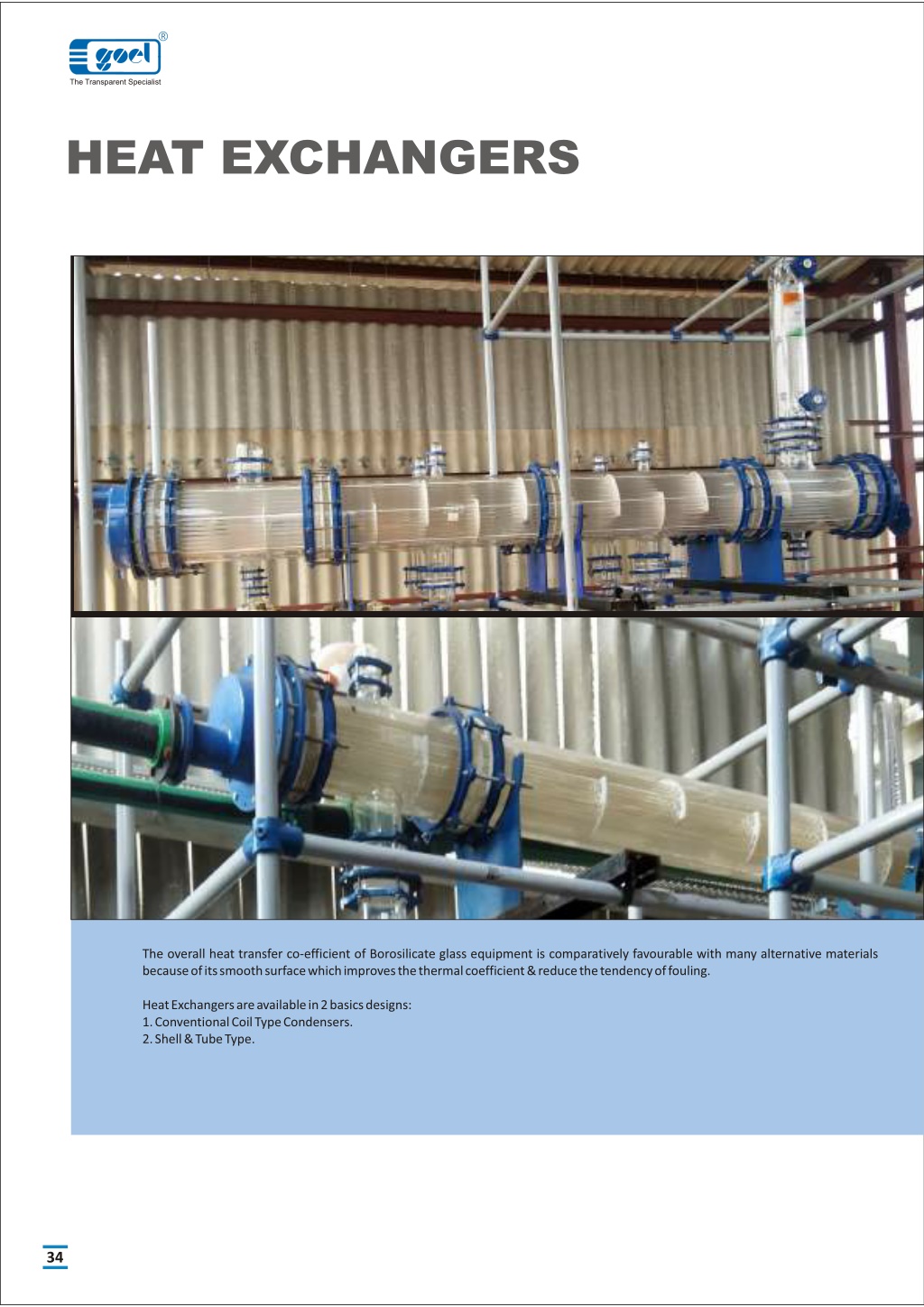
Heat Exchanger – Shell & Tube | Goel Scientific | Canada
We serve the best Shell & Tube, Shell & Tube, Manufacturer, Supplier, Seller, in Canada, USA Alberta, Calgary, British Columbia, Vancouver, Ontario, Quebec
Download Presentation

Please find below an Image/Link to download the presentation.
The content on the website is provided AS IS for your information and personal use only. It may not be sold, licensed, or shared on other websites without obtaining consent from the author. If you encounter any issues during the download, it is possible that the publisher has removed the file from their server.
You are allowed to download the files provided on this website for personal or commercial use, subject to the condition that they are used lawfully. All files are the property of their respective owners.
The content on the website is provided AS IS for your information and personal use only. It may not be sold, licensed, or shared on other websites without obtaining consent from the author.
E N D
Presentation Transcript
R The Transparent Specialist HEAT EXCHANGERS The overall heat transfer co-efficient of Borosilicate glass equipment is comparatively favourable with many alternative materials because of its smooth surface which improves the thermal coefficient & reduce the tendency of fouling. Heat Exchangers are available in 2 basics designs: 1. Conventional Coil Type Condensers. 2. Shell & Tube Type. 34
R HEAT EXCHANGERS The Transparent Specialist SHELL AND TUBE HEAT EXCHANGERS INTRODUCTION Shell & tube heat exchangers offer large surface area in combination with efficient heat transfer and compactness. These are widely used in industries for various duties like cooling, heating, condensation, evaporation etc. GOEL are the pioneers in the field of glass shell and tube heat exchangers in India and their product has a wide market acceptability. SALIENT FEATURES 1. Universal corrosion resistance an excellent alternative to expensive MOCs like graphite, hastelloy, copper titanium, tantalum and other exotic metals. 2. Excellent heat transfer as fouling does not occur on smooth glass surfaces. 3. Flexibility of installation vertical / horizontal. 4. Easy replacement of tubes for repair and cleaning. 5. Available in wide range of HTAs. 6. Ease of installation due to light weight. 7. Economical. 8. Suitable for applications where large HTAs are required in limited space. ADVANTAGES OVER CONVENTIONAL COIL TYPE HEAT EXCHANGERS (1) The overall heat transfer coefficient in shell and tube heat exchanger is about 3 times higher than in coil type heat exchanger. (2) The pressure drop in shell and tube heat exchanger is minimal compared to 2-3 kg/cm in coil side of coil type heat exchanger. (3) For requirement of higher heat transfer areas shell and tube heat exchanger is the only alternative. 2 HEADER CONSTRUCTION FEATURES SOCKET TUBE SHEET PACKING The glass tubes are sealed individually into PTFE tube sheet with special PTFE sockets and packing. This unique ferrule type sealing arrangement permits easy replacement and cleaning of tubes. Baffles on shell side ensure improved heat transfer by increased turbulance. Further details of construction can be seen in the diagram. - Made from SCHOTT DURAN. - Joint less tubes offer better pressure rating. GLASS TUBE TIE ROD BAFFLES SHELL TYPE Three basic versions * are available : Model RGG RGM RMG Material Of Construction Shell Tube Glass Glass Glass Glass Steel/FRP Glass Header Glass Steel/ FRP Glass Duty For heat transfer between two agressive media. For heat transfer between agressive media in shell & non- aggressive media in tubes. For heat transfer between aggressive media in tubes & non-aggressive media in shell. * GOEL provides assistance to clients for selecting the right model for specific duty. 35
R HEAT EXCHANGERS The Transparent Specialist DIMENSIONAL SPECIFICATIONS RGG/RMG Area (m ) DN DN1 DN2 DN3 DN4 H1 H2 L1 L2 L3 L4 L5 L6 No. of Tubes No. of Baffles Cat. Ref. 6/3 3 2500 1900 150 1600 250 125 1980 11 6/4 4 3100 2500 150 2200 250 125 2580 15 6/5 5 150 80 50 25 50 175 150 3700 3100 150 2800 250 125 3180 50 37 19 6/6 6 4300 3700 150 3400 250 125 3780 23 9/6 6 225 100 80 40 50 250 200 2620 3220 1900 2500 225 225 1450 2050 300 300 175 175 2000 2600 7 9/8 8 9/10 10 9/12 12 300 150 80 40 50 300 250 4520 2550 3800 1800 225 225 3350 1350 300 300 175 175 3900 1930 17 5 12/12 12 12/16 16 12/21 21 12/25 25 4550 3800 225 3350 300 175 3930 11 16/21 21 16/25 25 2 400 225 100 50 80 450 300 3100 2000 400 1200 550 225 2185 100 241 5 L 3820 3100 225 2650 300 175 3200 60 73 13 3150 2400 225 1950 300 175 2530 7 3950 3200 225 2750 300 175 3330 75 151 9 3500 2400 400 1600 550 225 2585 T 9 7 L L4 L4 L1 L3 L2 L2 DN1 DN2 DN4 T T H2 H2 DN DN3 DN3 H1 H1 DN2 RGG DN1 L6 TUBE BUNDLE RGM RANGE OF APPLICATIONS 0 0 Permissible temperature range for both shell & tube sides - 40 C to 150 C. Maximum permissible temperature difference between shell & tube sides 120 C. All sizes & models are suitable for full vacuum on both side. Maximum limiting pressures are tabulated here below : 0 2 Maximum Permissible Pressure Range, Kg/cm (g) Model Side 150 DN RGG Shell-Glass 2.0 Tube-Glass 2.0 Dome-Glass RGM Shell-Glass 2.0 Tube-Glass 3.5 Dome-Metal RMG Shell-Metal 3.5 Tube-Glass 2.0 Dome-Glass 225 DN 1.0 1.0 300 DN 1.0 1.0 1.0 3.5 1.0 3.5 3.5 1.0 3.5 1.0 The above ranges of application are admissible limiting values. For each specific case GOEL recommends the admissible operating data based on the relations between pressure and temperature, size and model. 36
R HEAT EXCHANGERS The Transparent Specialist PERFORMANCE & DESIGN DATA The particular advantage of shell & tube heat exchanger is high heat transfer performance. The relation between heat transfer and velocity of flow can be easily seen in the diagram. On receipt of the operating data from client the most favourable shell and tube heat exchanger is selected. This accurate design combined with most reliable quality assurance ensure economy and operational reliability for the user. For approximate sizing some typical heat transfer coefficients are given here below : 600 Cooling Water K Value in W / M K 500 Cooling Brine 2 400 300 U-Values Media use Steam water Condensation 200 2 2 kcal/m hr k 350-550 W/m k 300 410-640 100 0 Water-Water Cooling 250-350 290-410 0 0.5 1.0 1.5 2.0 2.5 Water-air Cooling 30-60 35-70 Coolant Velocity in M/Sec. 37
R HEAT EXCHANGERS The Transparent Specialist CONDENSERS Condensers are used for condensation of vapours and cooling of liquids. Condensers are made by fusing number of parallel coils in a glass shell. Coils are made in different diameters using tubes of different bores. DN DN The average co-efficient of heat transfer in coil condenser is considered as- 2 Condensation 200 - 270 Kcal/m ,hr, C appx. 2 Cooling 100 - 150 Kcal/m ,hr, C appx. o o d DN1 HE3/3.5* HE4/5* HE4/6* HE6/10 HE6/15* HE9/25* HE12/25 HE12/40* HE16/40 HE16/50 HE18/60 HE18/80 HE24/120 Free Coolant Rate Kg/hr. 1300 2400 2400 2600 2600 3300 5700 5700 6200 6200 4800 6200 6200 Max. Jacket Cap. Litre 2 4 6 9 11 18 25 35 60 70 100 110 265 L L Actual H.T.A. m 0.35 0.50 0.60 1.00 1.50 2.50 2.50 4.00 4.00 5.00 6.00 8.00 12.00 Cross Area Cm 5 30 30 52 52 125 175 175 450 450 820 820 1520 Cat. Ref. d/ DN1 16 19 19 25 25 25 25 25 25 25 40 40 50 2 2 DN 80 100 100 150 150 225 300 300 400 400 450 450 600 L L1 75 75 100 100 100 110 125 125 125 125 150 150 300 Type A A A B B B B B B B C C C DN1 d 600 600 750 600 850 800 600 900 600 700 750 900 1250 L1 L1 TYPE-B TYPE-A DN Precautions to be taken in use of condensers - Vapours should be passed through shell only. - Maximum pressure of coolant should be 2.7 bars. - Adequate flow of coolant should be used. - Steam should not be used in coils. - Coolant should not be heated to boiling point. - Coolant control valve should be turned slowly. - Coolant should be allowed to drain freely. - Brine can be used in coils in a closed circuit. - Water main should be connected with flexible hose. - Ensure no freezing of water remaining in the coils. - Condensers should be mounted vertically only. - Condensers can be mounted in series to provide larger surface area. L DN1 L1 L1 TYPE-C METHODS OF USE Vapours from bottom This method is simple to install over a reactor. However this results in condensate returning substantially at its condensing temperature. In this method care must be taken that condensate is not excessive that it can lead to "logging" the coils and create back pressure in the system. Generally a reflux divider is used below the condenser to take out the distillate. Coolent Coolent Vapour Vapour Vapours from top This method produce a cool condensate using the entire cooling surface area. This method should be used where the condensate can lead to "logging" of coils. Coolent Coolent Condensate * marked items are available fast. 38
R HEAT EXCHANGERS The Transparent Specialist BOILERS Boilers are used for vaporization of liquids by passing the steam in the coils. Boilers are made by fusing number of parallel coils in a glass shell. In Boilers, coils are designed to provide bigger cross section in the shell side as compared to condensers. The average heat transfer in Boilers is considered as 350 Kcal/m2,hr, C at a steam pressure of 3.5 bar. DN DN L1 o DN2 DN2 L DN2 HEB4/4 HEB6 HEB6/6 HEB9 HEB9/9 HEB12/12 Free Cross Area Cm 40 40 50 50 150 180 330 Actual H.T.A. m 0.15 0.15 0.35 0.35 1.00 1.00 1.30 Jacket Cap. Litre 2 3 5 7 16 20 40 Cat. Ref. HEB4 DN1 2 2 DN 100 100 150 150 225 225 300 DN1 25 100 40 150 40 225 300 DN2 25 25 25 25 25 25 25 L L1 100 100 100 100 100 100 125 Type A B A B A B B DN2 DN2 HEB - TYPE-A 375 400 450 500 700 700 700 L1 DN1 HEB - TYPE-B Notes on use of Boilers : - Steam should be passed in the coils at a maximum pressure of 3.5 bar which is equivalent O to a temperature of 147 C. - For higher temperature (maximum upto 200 C) heat transfer fluids can be passed in the coils. - Cold liquids - Cold liquids should be preheated for better results. - Boilers should bemounted in anexternal circulatory loop (as shown in figure) and not direct at the bottom of flask or column - Under certain circumstances, boilers can be mounted in series to provide larger heat transfer area. O ANGLED HOSE CONNECTOR ASSEMBLIES Metal / Plastic angled hose connector assemblies are available to connect the flexible hose to the condensers. These are provide with a mating flange, a rubber gasket and nut bolts. L Cat.Ref. PMC1 DN 25 d 22 L 70 d IMMERSIONS Immersion heat exchangers are used to control exothermic reaction in glass vessels. They can be used with vessels having wider bottom outlet (type VSR and VSE). These are provided with a central hole through the coil battery so that a special, extended type, stirrer can be fitted which extends to the bottom of heat exchanger and provide through action. In most applications, cooling water is used in coils (max. pressure 2.7 bar g.), but they can also be used with steam (max. pressure 3.5 bar g.). In latter case the coils must be completely immersed in liquid. Immersions are not recommended for use with products which have a tendency to crystalise. d L1 DN L Cat. Ref. HEM6 HEM9 Actual H.T.A. m 0.4 0.6 DN2 DN2 DN1 HEM L2 2 DN 150 225 DN1 40 40 DN2 25 25 L L1 200 200 L2 75 75 d 200 300 145 200 39
R HEAT EXCHANGERS The Transparent Specialist PRODUCT COOLERS Product coolers are used for cooling of liquids, typically, for the cooling of distillates from the distillation columns. Unlike coil condensers, in product coolers, product travels through the coil battery and coolant through shell. This provides more resident time to the product to be cooled. For direct connection with distillate lines, all the product coolers are provided with 25 DN connections. DN1 DN1 DN2 DN2 DN L DN L Cat.Ref. HEF1/1* HEF1/2* HEF1/3.5* HEF1/5* HEF1/10 HEF1/15 Actual HTA m 0.1 0.2 0.35 0.5 0.7 1.25 2 DN 50 50 80 100 150 150 DN1 25 25 25 25 25 25 DN2 12 12 16 19 25 25 L Type A A A A B B 450 600 600 600 600 850 DN2 DN2 DN1 DN1 HEF HEF TYPE - B TYPE - A UTILITY CONNECTION FOR CONDENSER When installing coil type heat exchangers appropriate precautions should be taken. The main points to be taken into account when planning to use these items as coolers are (See also flow chart below). FLEXIBLE HOSE UTILITY OUTLET PRESSURE GAUGE NON RETURN VALVE FLEXIBLE HOSE VALVE CONTROL VALVE DRAIN UTILITY RETURN UTILITY SUPPLY 40



